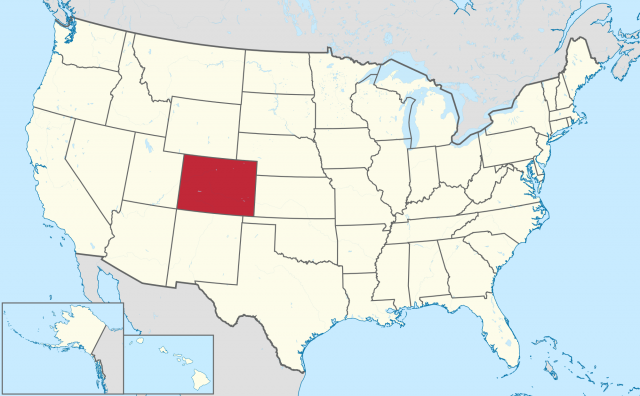The State of Colorado
AT A GLANCE
Name: Colorado is a Spanish word that means “colored red.” The name was first given to the Colorado River by Spanish explorers because it flows through red stone canyons.
Nickname: Centennial State
Capital: Denver
Size: 104,100 sq. mi.
Population: 5,356,000 (2014)
Statehood: Colorado became the 38th state on August 1, 1876.
Electoral votes: 9 (2016)
U.S. Representatives: 6 (until 2016)
State tree: Colorado blue spruce
State flower: Rocky Mountain columbine
State animal: bighorn sheep
Highest point: Mount Elbert, 14,433 ft.

THE PLACE
Colorado is located partly in the Rocky Mountains. Because the western portion of the state is mountainous, Colorado has the highest average elevation of any state. More than 800 of its peaks are higher than 10,000 feet, and more than 50 are higher than 14,000 feet.
The western half of the state is separated from the eastern half by the Continental Divide, the high point of the Rocky Mountains that runs from north to south and separates the waters that flow west into the Pacific Ocean from those that flow east. The eastern half of the state, an area of plains and prairies, is part of the Great Plains region. This area becomes gradually higher as it slopes to meet the Rockies in the west, and it is good farming and cattle-raising land.
The alpine terrain of the western mountains is full of towering peaks, wide valleys, jagged canyons, high plateaus, and deep basins. Six major rivers flow through Colorado. The Colorado River is the most important one because it supplies hydroelectricity and water for irrigation. Over many years, the Colorado River carved out the Grand Canyon (in Arizona) in its southwest journey to the Gulf of California.
Colorado's weather is typically cool and pleasant in summer, and winters are very snowy. Colorado is rich in many minerals, including gold, silver, uranium, coal, molybdenum (used in making steel), and petroleum.
Facts and Firsts
- Colorado's southwest corner is part of the Four Corners. There, the borders of Colorado, Arizona, New Mexico, and Utah all touch. This is the only place in the United States where four states meet.
- Colorado is home to the world's highest suspension bridge, the Royal Gorge Bridge, located near Canon City. The bridge crosses the Arkansas River at a height of 1,053 feet.
- Great Sand Dunes National Monument, located outside Alamosa, has the tallest sand dune in America.
- Mesa Verde National Park contains more than 4,000 cliff dwellings, as well as a four-story city, created by the Ancestral Pueblo people between 600 and the late 1200s.These Native American inhabitants gradually abandoned the cliffs by 1300.
- Katherine Lee Bates was inspired to compose the song “America the Beautiful” after climbing to the top of Pikes Peak, the most famous mountain in Colorado. Pikes Peak is 14,110 feet above sea level.
- Denver annually hosts the world's largest rodeo, the Western Stock Show.
- Denver is one of several American cities that claim to be the home of the original cheeseburger. A Denver monument reads, “On this site in 1935, Louis E. Ballast created the cheeseburger.”
- The Colorado state capitol building is decorated with beulah red marble from the town of Beulah. No more of this marble exists; all of it known in the world was used in the construction of the capitol.
THE PAST
Evidence of Colorado's long geographical history can be seen in Great Sand Dunes National Monument. For thousands of years, prevailing southwesterly winds blew over the San Juan Mountains and down over the Rio Grande flood plain, picking up sand particles on the way. These particles were then deposited at the east edge of the river valley as the wind moved upward to cross the Sangre de Cristo Mountains. This process continues today as the wind changes the shape and sand patterns of the dunes daily.
Colorado has a long human history, stretching back before the year 600, when Native Americans constructed cliff dwellings and cities in what is now Mesa Verde National Park, near Cortez. Although these people, known as Anasazi, mysteriously vanished from the cliffs by 1300, Colorado was home to many Native American groups when the Spanish arrived there in the 1500s.
Eastern Colorado became a U.S. territory in 1803 as a part of the Louisiana Purchase. That agreement with France gave the United States all of France's former territories north of Mexico and south of Canada. The central part of the state became a territory in 1845. Western Colorado was added after the United States acquired it, along with other territory, from Mexico in the Mexican-American War, which ended in 1848.
Gold was discovered in Colorado in 1858, and a rush of fortune seekers and settlers began to populate the area. When Colorado became a full-fledged state on August 1, 1876, it was an important agricultural and mining region.
THE PRESENT
The eastern part of Colorado is still an important agricultural area where many fruits and vegetables grow on irrigated land. Cattle are raised in nonirrigated areas, and beef is another of Colorado's chief products.
Colorado's beautiful scenery, history, extensive park system, and ideal skiing terrain make tourism an important industry. Tourism provides jobs in food service, hotels, transportation, and entertainment.
Although Colorado's past economy was based on mining and agriculture, the state's economy now centers on high technology and the service industries. While Colorado is a modern, industrial state, its residents strive to preserve its history and natural splendor for future generations.
Born in Colorado
- Tim Allen, actor and comedian
- M. Scott Carpenter, astronaut
- Lon Chaney, actor
- Mary Coyle Chase, playwright
- Chipeta, Native American negotiator
- Jack Dempsey, boxer
- Douglas Fairbanks, actor
- Eugene Fodor, violinist
- Willard Libby, scientist
- Ouray, Ute chief
- Florence Sabin, scientist
- Lowell Thomas, commentator and author
- Dalton Trumbo, screenwriter and novelist
- Byron R. White, jurist
- Paul Whiteman, conductor